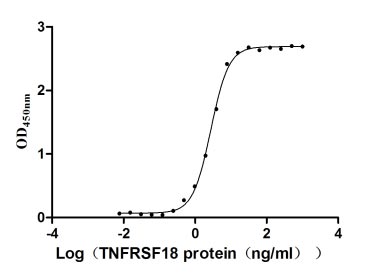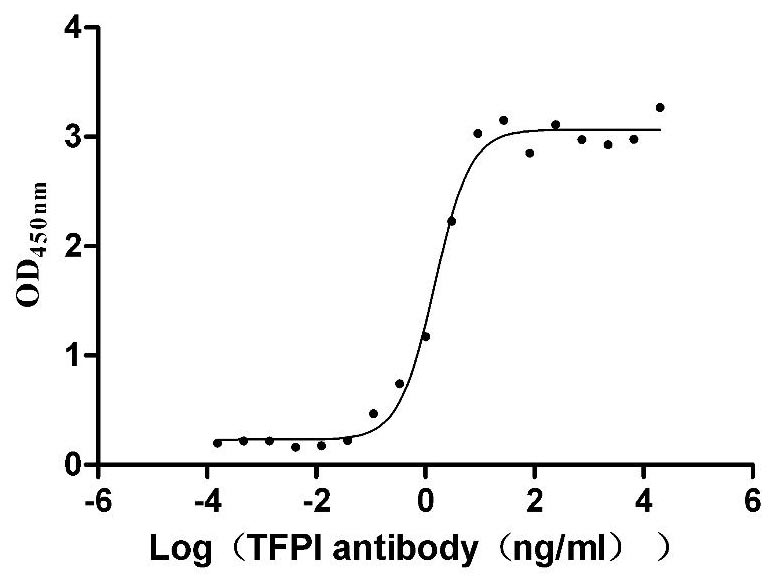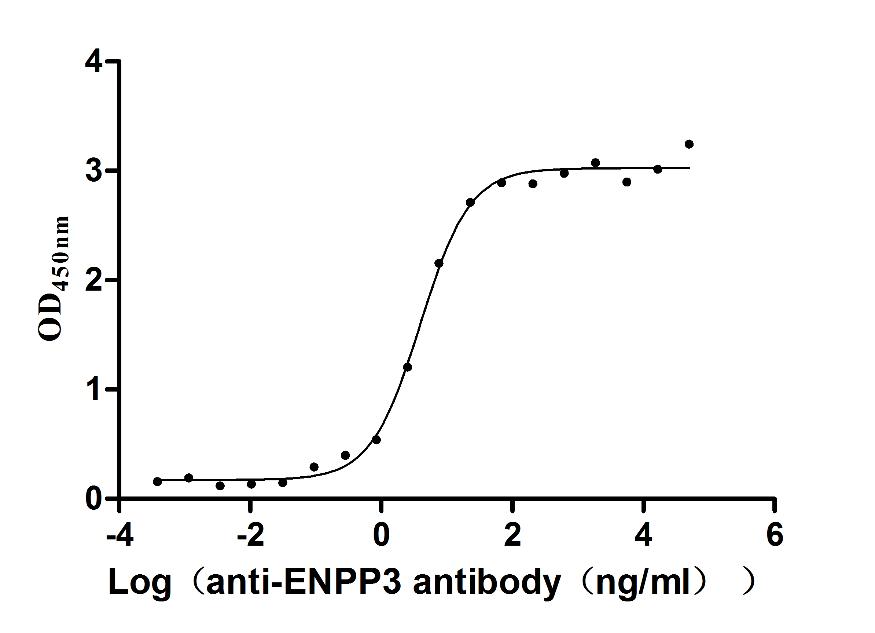Recombinant Rat Sphingosine 1-phosphate receptor 1 (S1pr1)
-
货号:CSB-CF020650RA
-
规格:
-
来源:in vitro E.coli expression system
-
其他:
产品详情
-
基因名:
-
Uniprot No.:
-
别名:S1pr1; Edg1; Sphingosine 1-phosphate receptor 1; S1P receptor 1; S1P1; Endothelial differentiation G-protein coupled receptor 1; Sphingosine 1-phosphate receptor Edg-1; S1P receptor Edg-1; CD antigen CD363
-
种属:Rattus norvegicus (Rat)
-
蛋白长度:Full length protein
-
表达区域:1-383
-
氨基酸序列MVSSTSIPVVKALRSQVSDYGNYDIIVRHYNYTGKLNIGVEKDHGIKLTSVVFILICCLI ILENIFVLLTIWKTKKFHRPMYYFIGNLALSDLLAGVAYTANLLLSGATTYKLTPAQWFL REGSMFVALSASVFSLLAIAIERYITMLKMKLHNGSNSSRSFLLISACWVISLILGGLPI MGWNCISSLSSCSTVLPLYHKHYILFCTTVFTLLLLSIVILYCRIYSLVRTRSRRLTFRK NISKASRSSEKSLALLKTVIIVLSVFIACWAPLFILLLLDVGCKAKTCDILYKAEYFLVL AVLNSGTNPIIYTLTNKEMRRAFIRIISCCKCPNGDSAGKFKRPIIPGMEFSRSKSDNSS HPQKDDGDNPETIMSSGNVNSSS
Note: The complete sequence including tag sequence, target protein sequence and linker sequence could be provided upon request. -
蛋白标签:N-terminal 10xHis-tagged
-
产品提供形式:Liquid or Lyophilized powder
Note: We will preferentially ship the format that we have in stock, however, if you have any special requirement for the format, please remark your requirement when placing the order, we will prepare according to your demand. -
缓冲液:Lyophilized from Tris/PBS-based buffer, 6% Trehalose, pH 8.0
-
储存条件:Store at -20°C/-80°C upon receipt, aliquoting is necessary for mutiple use. Avoid repeated freeze-thaw cycles.
-
保质期:The shelf life is related to many factors, storage state, buffer ingredients, storage temperature and the stability of the protein itself.
Generally, the shelf life of liquid form is 6 months at -20°C/-80°C. The shelf life of lyophilized form is 12 months at -20°C/-80°C. -
货期:Basically, we can dispatch the products out in 1-3 working days after receiving your orders. Delivery time may differ from different purchasing way or location, please kindly consult your local distributors for specific delivery time.Note: All of our proteins are default shipped with normal blue ice packs, if you request to ship with dry ice, please communicate with us in advance and extra fees will be charged.
-
注意事项:Repeated freezing and thawing is not recommended. Store working aliquots at 4°C for up to one week.
-
Datasheet & COA:Please contact us to get it.
相关产品
靶点详情
-
功能:G-protein coupled receptor for the bioactive lysosphingolipid sphingosine 1-phosphate (S1P) that seems to be coupled to the G(i) subclass of heteromeric G proteins. Signaling leads to the activation of RAC1, SRC, PTK2/FAK1 and MAP kinases. Plays an important role in cell migration, probably via its role in the reorganization of the actin cytoskeleton and the formation of lamellipodia in response to stimuli that increase the activity of the sphingosine kinase SPHK1. Required for normal chemotaxis toward sphingosine 1-phosphate. Required for normal embryonic heart development and normal cardiac morphogenesis. Plays an important role in the regulation of sprouting angiogenesis and vascular maturation. Inhibits sprouting angiogenesis to prevent excessive sprouting during blood vessel development. Required for normal egress of mature T-cells from the thymus into the blood stream and into peripheral lymphoid organs. Plays a role in the migration of osteoclast precursor cells, the regulation of bone mineralization and bone homeostasis. Plays a role in responses to oxidized 1-palmitoyl-2-arachidonoyl-sn-glycero-3-phosphocholine by pulmonary endothelial cells and in the protection against ventilator-induced lung injury.
-
基因功能参考文献:
- There is a marked up-regulation of S1PR1 in hippocampus following traumatic brain injury. PMID: 28018679
- maternal lead in the blood affects levels of sphingosine-1-phosphate (S1P) and expression of S1P receptor 1 in the brain of the rat in the perinatal period PMID: 27697711
- S1P regulates cell proliferation and angiogenesis via different receptors. PMID: 26543024
- The neuronal sphingosine-1-phosphate/S1PR1/STAT3 signalling axis plays a critical role in the control of energy homeostasis. PMID: 25255053
- findings identify for the first time the S1P/S1PR1 axis as a promising molecular and therapeutic target in chemotherapy-induced painful peripheral neuropathy, establish a mechanistic insight into the biomolecular signaling pathways PMID: 24876379
- We demonstrate that restoration of cardiac plasma membrane levels of S1PR1 produces beneficial effects that counterbalance the deleterious beta1AR overstimulation in heart failure. PMID: 23969695
- Data indicate that inhibition of S1PR1 or S1PR3 decreased the velocity of S1P-induced VSMC migration by almost 75%. PMID: 22828274
- The S1PR1 receptors in sensory ganglia cells play an important role in regulating behavioral sensitivity during inflammation. PMID: 22445889
- The results obtained from the single defined neurons show that S1PR(1) plays a prominent but not exclusive role in the enhancement of neuronal excitability. PMID: 22805346
- analysis of quinolinone-based agonists of S1P PMID: 22104144
- The sphingosine-1-phosphate (S1P)-to-S1PR-1 pathway is implicated as a downstream signaling pathway in ceramide-induced hyperalgesia. PMID: 21605625
- Purification and identification of activating enzymes of CS-0777, a selective sphingosine 1-phosphate receptor 1 modulator, in erythrocytes. PMID: 21613209
- FTY720 (Gilenya) phosphate selectivity of sphingosine 1-phosphate receptor subtype 1 (S1P1) G protein-coupled receptor requires motifs in intracellular loop 1 and transmembrane domain 2 PMID: 21719706
- Sphingosine 1-phosphate 1 receptor (S1P1R) agonists regulate podocyte-specific proteins PMID: 21289599
- These results indicate that S1PR(1) plays a prominent, although not exclusive, role in mediating the enhancement of excitability of sensory neurons. PMID: 20844107
- The activation of endothelial S1P(R1) is responsible for the protective action of sphingosine-1-phosphate on microvessel permeability. PMID: 20729401
- PKC inhibition therefore may contribute to lymphopenia by down-regulating S1P(1) receptor cell surface expression independently from its activation. PMID: 20032465
- This lipid mediator in neural stem/progenitor cell migration may have therapeutic potential in spinal cord injury. PMID: 16990586
- These results indicate that CNS S1P receptors are part of a physiologically relevant and widespread neuromodulatory system, and that the S1P(1) receptor contributes to S1P-mediated antinociception. PMID: 19493165
显示更多
收起更多
-
亚细胞定位:Cell membrane; Multi-pass membrane protein. Endosome. Membrane raft.
-
蛋白家族:G-protein coupled receptor 1 family
-
数据库链接:
KEGG: rno:29733
STRING: 10116.ENSRNOP00000052627
UniGene: Rn.109455
Most popular with customers
-
Recombinant Human Angiotensin-converting enzyme 2 (ACE2), partial,Biotinylated (Active)
Express system: Mammalian cell
Species: Homo sapiens (Human)
-
Recombinant Macaca fascicularis Angiotensin-converting enzyme (ACE2), partial (Active)
Express system: Mammalian cell
Species: Macaca fascicularis (Crab-eating macaque) (Cynomolgus monkey)
-
Recombinant Human Tumor necrosis factor receptor superfamily member 18 (TNFRSF18), partial (Active)
Express system: Mammalian cell
Species: Homo sapiens (Human)
-
Recombinant Human Insulin growth factor-like family member 1 (IGFL1) (Active)
Express system: Mammalian cell
Species: Homo sapiens (Human)
-
Recombinant Human Tissue factor pathway inhibitor (TFPI), partial (Active)
Express system: Mammalian cell
Species: Homo sapiens (Human)
-
Recombinant Macaca mulatta Semaphorin-4D isoform 1 (SEMA4D), partial (Active)
Express system: Mammalian cell
Species: Macaca mulatta (Rhesus macaque)
-
Express system: Mammalian cell
Species: Macaca fascicularis (Crab-eating macaque) (Cynomolgus monkey)
-
Recombinant Human C-C chemokine receptor type 9 (CCR9)-VLPs (Active)
Express system: Mammalian cell
Species: Homo sapiens (Human)




















